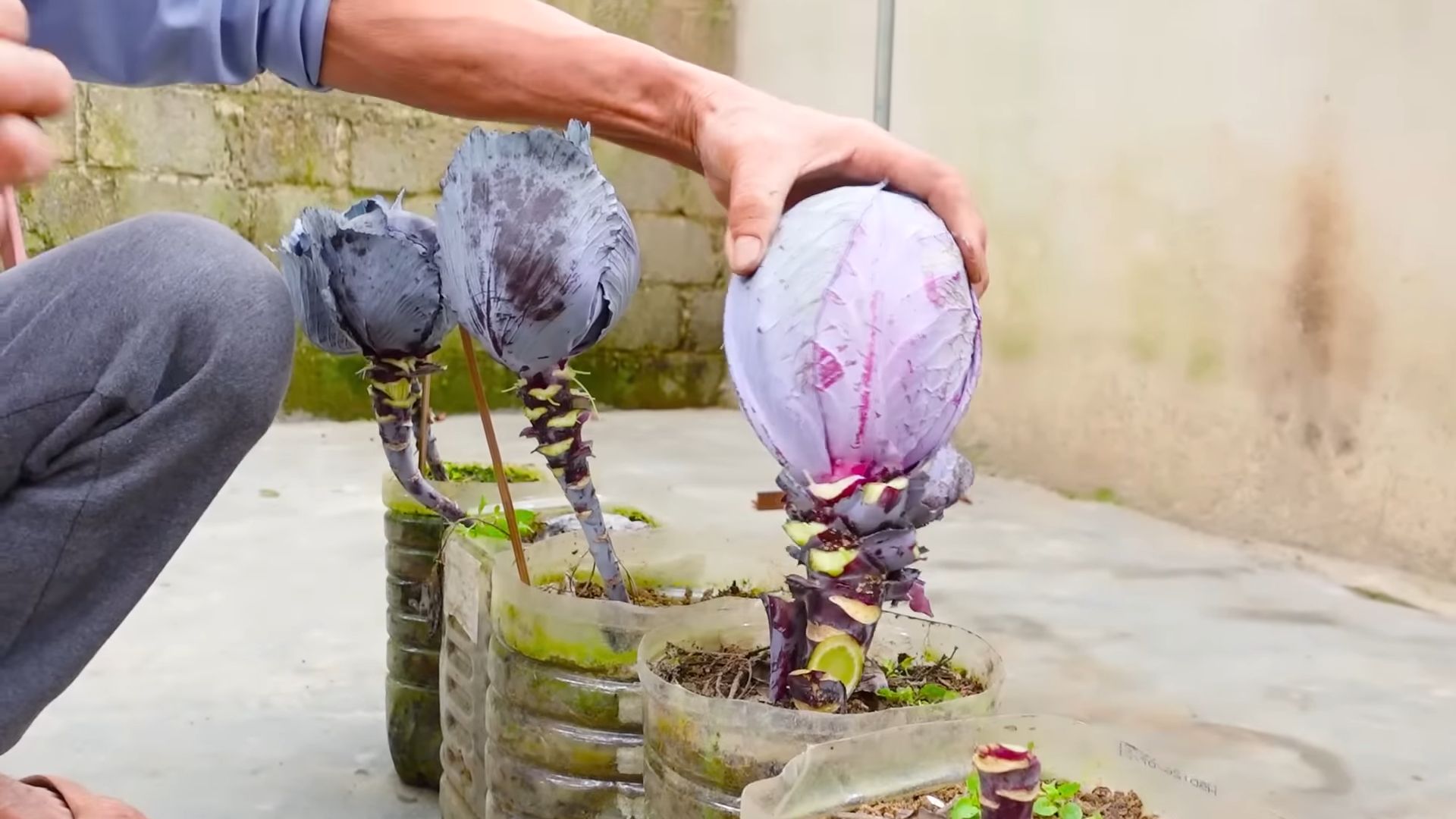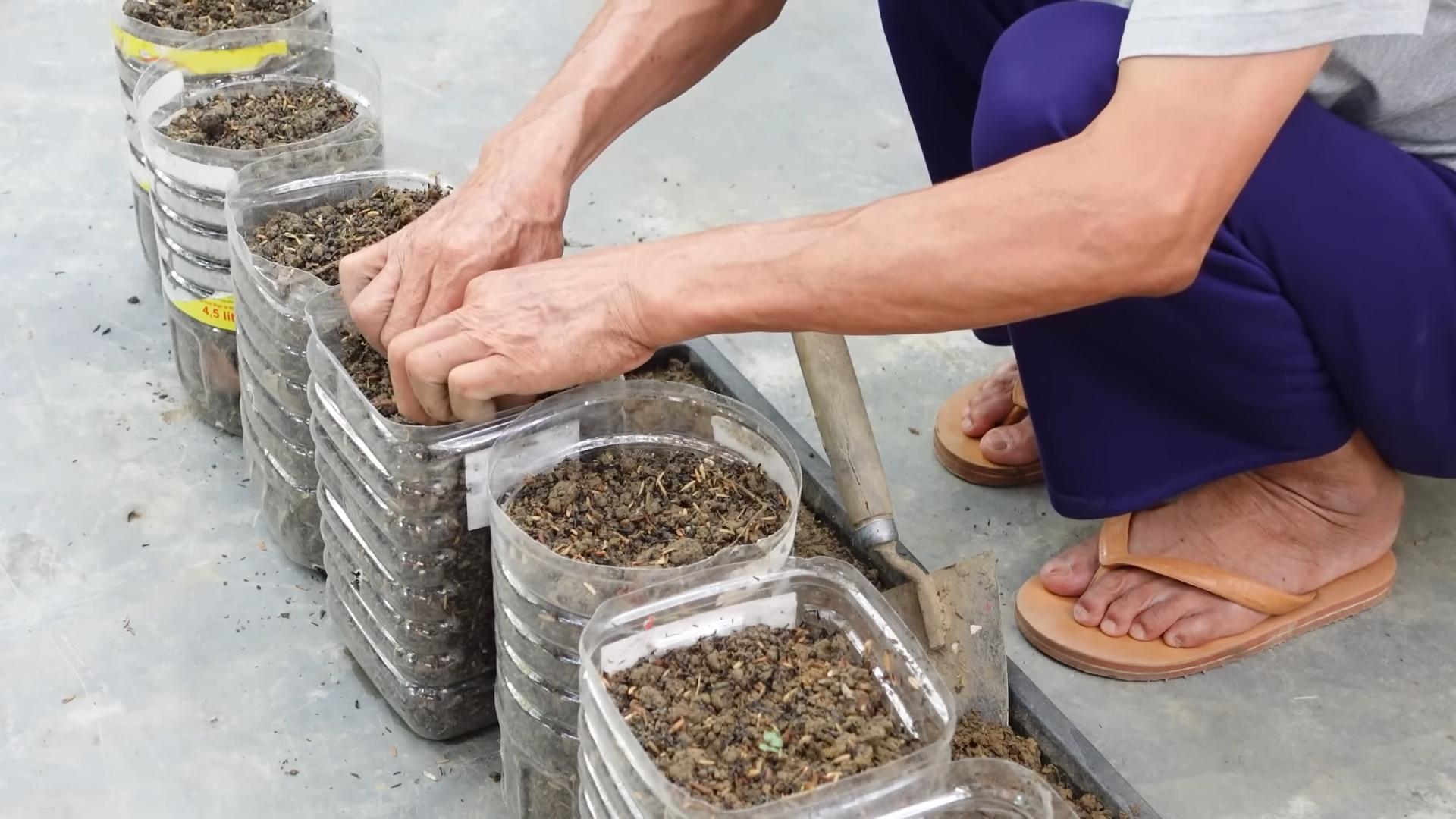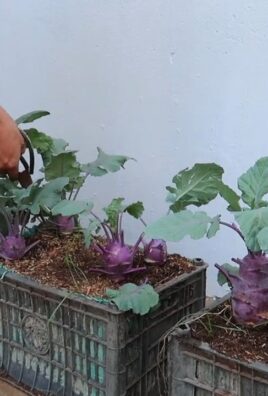Grow Purple Cabbage Easily? Absolutely! Imagine vibrant, jewel-toned purple cabbages bursting forth from your very own garden. It’s not just a dream; it’s an achievable reality with a few clever tricks and DIY techniques. For centuries, cabbage, in all its forms, has been a staple in diets across the globe, from the hearty stews of Eastern Europe to the vibrant slaws of North America. But the purple variety? It adds a touch of elegance and a nutritional punch that’s hard to beat.
I know what you might be thinking: “Gardening is hard!” or “I don’t have a green thumb!”. But trust me, growing your own purple cabbage doesn’t require expert skills. This guide is designed for everyone, from the seasoned gardener to the absolute beginner. We’ll break down the process into simple, manageable steps, revealing insider secrets that will have you harvesting beautiful, healthy purple cabbages in no time.
Why bother with the effort? Because fresh, homegrown produce tastes infinitely better than anything you can buy in a store. Plus, you’ll know exactly what went into growing it – no harmful pesticides or mystery ingredients. And let’s be honest, there’s a certain satisfaction that comes from nurturing a plant from seed to table. So, are you ready to grow purple cabbage easily and impress your friends and family with your gardening prowess? Let’s get started!

Grow Your Own Vibrant Purple Cabbage: A Beginner’s Guide
Hey there, fellow garden enthusiasts! Ever dreamt of adding a splash of color and nutrition to your meals straight from your backyard? Well, look no further! I’m going to walk you through the surprisingly simple process of growing your very own gorgeous purple cabbage. Trust me, it’s easier than you think, and the rewards are oh-so-delicious.
Choosing the Right Variety
Before we dive into the nitty-gritty, let’s talk about choosing the right purple cabbage variety. There are a few options out there, each with its own unique characteristics. Here are a few popular choices:
* ‘Red Acre’: This is a classic, reliable variety that produces medium-sized, round heads with a deep purple color. It’s known for its good storage capabilities, making it a great choice if you want to harvest and enjoy your cabbage over a longer period.
* ‘Ruby Ball’: As the name suggests, this variety produces perfectly round, compact heads with a vibrant ruby-red hue. It’s a relatively early maturing variety, so you won’t have to wait as long to harvest.
* ‘Scarlet O’Hara’: This is another early maturing variety, known for its beautiful, slightly flattened heads and intense purple color. It’s also known for its good disease resistance.
* ‘Primero’: If you’re looking for a very early variety, ‘Primero’ is a great option. It produces small to medium-sized heads with a deep purple color and a mild flavor.
I personally love ‘Red Acre’ because of its reliability and storage capabilities, but feel free to experiment and find the variety that best suits your needs and preferences!
Getting Started: Planting Purple Cabbage
Okay, now for the fun part: planting! Purple cabbage, like other cabbages, is a cool-season crop, meaning it thrives in cooler temperatures. This means you’ll want to plant it either in early spring or late summer for a fall harvest.
Here’s a breakdown of the planting process:
* Starting Seeds Indoors (Recommended):
* Timing: Start your seeds about 6-8 weeks before the last expected frost in spring, or 10-12 weeks before the first expected frost in fall.
* Materials: You’ll need seed starting trays or small pots, seed starting mix, purple cabbage seeds, and a spray bottle.
* Sowing: Fill your trays or pots with seed starting mix. Moisten the mix with the spray bottle. Sow 2-3 seeds per cell or pot, about ¼ inch deep. Gently cover the seeds with more mix.
* Watering: Keep the soil consistently moist, but not soggy. Use the spray bottle to avoid overwatering.
* Light: Place the trays or pots under grow lights or in a sunny window. If using a window, rotate the trays regularly to ensure even growth.
* Temperature: Maintain a temperature of around 65-75°F (18-24°C) for optimal germination.
* Thinning: Once the seedlings have emerged and have a few true leaves, thin them to one plant per cell or pot. Choose the strongest, healthiest seedling to keep.
* Direct Sowing (Less Recommended):
* Timing: Direct sow seeds 2-3 weeks before the last expected frost in spring, or 8-10 weeks before the first expected frost in fall.
* Soil Preparation: Prepare your garden bed by loosening the soil and adding compost or other organic matter.
* Sowing: Sow seeds about ½ inch deep and 1-2 inches apart in rows.
* Watering: Keep the soil consistently moist until the seedlings emerge.
* Thinning: Once the seedlings have emerged and have a few true leaves, thin them to 18-24 inches apart.
I highly recommend starting your seeds indoors, as it gives you more control over the growing environment and allows you to get a head start on the season.
Transplanting Your Seedlings
Once your seedlings have developed several sets of true leaves and are about 4-6 inches tall, it’s time to transplant them into your garden.
Here’s how to do it:
1. Harden Off: Before transplanting, you need to “harden off” your seedlings. This means gradually exposing them to outdoor conditions over a period of 7-10 days. Start by placing them in a sheltered spot outdoors for a few hours each day, gradually increasing the amount of time they spend outside. This will help them acclimate to the sun, wind, and temperature changes.
2. Prepare the Garden Bed: Choose a sunny location in your garden with well-drained soil. Purple cabbage prefers soil that is rich in organic matter. Amend the soil with compost or well-rotted manure before planting.
3. Spacing: Space your seedlings 18-24 inches apart in rows that are 24-36 inches apart. This will give them enough room to grow and develop their heads.
4. Planting: Dig a hole that is slightly larger than the root ball of the seedling. Gently remove the seedling from its pot and place it in the hole. Make sure the top of the root ball is level with the soil surface.
5. Backfill: Fill the hole with soil and gently firm it around the base of the plant.
6. Watering: Water the seedlings thoroughly after planting.
Caring for Your Purple Cabbage
Now that your purple cabbage is in the ground, it’s time to provide it with the care it needs to thrive.
Here’s what you need to do:
1. Watering: Purple cabbage needs consistent moisture, especially during hot, dry weather. Water deeply and regularly, aiming to keep the soil consistently moist but not soggy.
2. Fertilizing: Fertilize your purple cabbage every 2-3 weeks with a balanced fertilizer. You can also side-dress with compost or well-rotted manure.
3. Weeding: Keep the area around your purple cabbage free of weeds. Weeds compete with your cabbage for nutrients and water.
4. Pest Control: Purple cabbage can be susceptible to a few pests, such as cabbage worms, aphids, and flea beetles. Inspect your plants regularly for signs of pests and take action as needed. You can use organic pest control methods, such as insecticidal soap or neem oil.
5. Mulching: Apply a layer of mulch around your purple cabbage to help retain moisture, suppress weeds, and regulate soil temperature.
Harvesting Your Purple Cabbage
After all your hard work, it’s finally time to harvest your beautiful purple cabbage!
Here’s how to know when it’s ready:
1. Maturity: Purple cabbage typically takes 70-100 days to mature, depending on the variety.
2. Head Size: The head should be firm and compact, and the size should be appropriate for the variety you’re growing.
3. Color: The color should be a deep, vibrant purple.
Here’s how to harvest:
1. Cut: Use a sharp knife to cut the head from the stem, leaving a few outer leaves attached.
2. Storage: Store your purple cabbage in the refrigerator for up to 2 weeks.
Troubleshooting Common Problems
Even with the best care, you might encounter a few problems along the way. Here are some common issues and how to address them:
* Cabbage Worms: These green caterpillars can devour your cabbage leaves. Handpick them off the plants or use Bacillus thuringiensis (Bt), a natural bacteria that is effective against cabbage worms.
* Aphids: These tiny insects can suck the sap from your cabbage leaves, causing them to curl and yellow. Spray them with insecticidal soap or neem oil.
* Flea Beetles: These small, jumping beetles can create small holes in your cabbage leaves. Cover your plants with row covers to prevent flea beetles from reaching them.
* Clubroot: This fungal disease can cause your cabbage roots to swell and distort. Prevent clubroot by planting in well-drained soil and avoiding planting cabbage in the same location year after year.
Enjoying Your Homegrown Purple Cabbage
Now that you’ve harvested your beautiful purple cabbage, it’s time to enjoy the fruits (or rather, vegetables) of your labor! Purple cabbage is incredibly versatile and can be used in a variety of dishes.
Here are a few ideas:
* Salads: Shredded purple cabbage adds a vibrant color and crunchy texture to salads.
* Slaws: Purple cabbage is a key ingredient in many slaws.
* Stir-fries: Add chopped purple cabbage to stir-fries for a healthy and colorful boost.
*

Conclusion
So, there you have it! Growing your own vibrant, delicious purple cabbage isn’t just a gardening project; it’s an investment in your health, your kitchen, and your connection to the natural world. We’ve walked you through the simple steps, demystified the process, and armed you with the knowledge to cultivate these beautiful heads of cabbage right in your own backyard, balcony, or even a sunny windowsill.
Why is this DIY trick a must-try? Because it empowers you to control the quality of your food, reduce your carbon footprint, and experience the unparalleled satisfaction of harvesting something you nurtured from seed to table. Store-bought purple cabbage simply can’t compare to the freshness and flavor of homegrown. Plus, you’ll avoid the pesticides and herbicides often used in commercial farming, ensuring a healthier and more sustainable choice for you and your family.
But the benefits don’t stop there. Growing purple cabbage is also incredibly rewarding. Watching those tiny seedlings sprout and gradually transform into robust, colorful heads is a testament to the power of nature and your own green thumb. It’s a therapeutic activity that connects you to the earth and provides a sense of accomplishment.
And let’s not forget the versatility of purple cabbage in the kitchen! From vibrant salads and slaws to tangy ferments and hearty stir-fries, this vegetable adds a pop of color and a nutritional boost to countless dishes. Imagine the pride you’ll feel when you serve a meal featuring purple cabbage you grew yourself!
Ready to take your purple cabbage growing to the next level? Consider these variations:
* Experiment with different varieties: There are several cultivars of purple cabbage, each with its own unique characteristics. Try growing ‘Red Acre’ for its early maturity or ‘Ruby Perfection’ for its deep color and excellent storage capabilities.
* Companion planting: Plant your purple cabbage alongside beneficial companions like dill, chamomile, or rosemary to deter pests and attract pollinators.
* Succession planting: Extend your harvest season by planting new seedlings every few weeks. This will ensure a continuous supply of fresh purple cabbage throughout the growing season.
* Fermenting: Turn your homegrown purple cabbage into delicious and healthy sauerkraut or kimchi. The fermentation process enhances the flavor and nutritional value of the cabbage, creating a probiotic-rich superfood.
We’re confident that you’ll find growing purple cabbage to be a fun, rewarding, and delicious experience. Don’t be intimidated by the process – it’s easier than you think! With a little patience and care, you’ll be harvesting your own beautiful heads of purple cabbage in no time.
So, what are you waiting for? Grab some seeds, prepare your soil, and embark on your purple cabbage growing adventure today! We can’t wait to hear about your experiences. Share your photos, tips, and triumphs with us in the comments below. Let’s build a community of purple cabbage enthusiasts and inspire others to grow their own food! We are sure that you will be able to grow purple cabbage with ease.
Frequently Asked Questions (FAQ)
What is the best time of year to plant purple cabbage?
The ideal time to plant purple cabbage depends on your climate. In general, it’s best to start seeds indoors 6-8 weeks before the last expected frost in spring for a summer harvest, or direct sow seeds in mid-summer for a fall harvest. Purple cabbage prefers cooler temperatures, so avoid planting during the hottest months of the year. If you live in a region with mild winters, you may even be able to grow purple cabbage year-round. Check your local planting calendar for specific recommendations based on your area.
How much sunlight does purple cabbage need?
Purple cabbage thrives in full sun, requiring at least 6 hours of direct sunlight per day. If you’re growing your cabbage indoors, make sure to provide adequate artificial light, such as grow lights, to supplement natural sunlight. Insufficient sunlight can result in leggy plants with poor head formation.
What kind of soil is best for growing purple cabbage?
Purple cabbage prefers well-drained, fertile soil that is rich in organic matter. The ideal soil pH is between 6.0 and 7.0. Before planting, amend your soil with compost, aged manure, or other organic materials to improve drainage, fertility, and water retention. You can also add a slow-release fertilizer to provide essential nutrients throughout the growing season.
How often should I water my purple cabbage plants?
Purple cabbage needs consistent moisture to thrive. Water deeply and regularly, especially during dry periods. Aim to keep the soil consistently moist but not waterlogged. Mulching around your plants can help retain moisture and suppress weeds. Check the soil moisture regularly by sticking your finger into the soil. If the top inch feels dry, it’s time to water.
What are some common pests and diseases that affect purple cabbage?
Purple cabbage can be susceptible to various pests and diseases, including cabbage worms, aphids, flea beetles, clubroot, and black rot. To prevent pest and disease problems, practice good garden hygiene, such as removing plant debris and weeds. Use row covers to protect your plants from pests. Inspect your plants regularly for signs of infestation or disease and take appropriate action, such as hand-picking pests, using insecticidal soap, or applying a fungicide. Crop rotation can also help prevent soilborne diseases.
How do I know when my purple cabbage is ready to harvest?
Purple cabbage is typically ready to harvest when the head is firm and solid. The size of the head will vary depending on the variety, but generally, a mature head will be about 6-8 inches in diameter. To harvest, use a sharp knife to cut the head from the stem, leaving a few outer leaves intact. You can store harvested purple cabbage in the refrigerator for several weeks.
Can I grow purple cabbage in containers?
Yes, you can successfully grow purple cabbage in containers, provided you choose a large enough container (at least 12 inches in diameter) and use a well-draining potting mix. Make sure the container has drainage holes to prevent waterlogging. Container-grown purple cabbage may require more frequent watering and fertilization than plants grown in the ground.
How can I encourage my purple cabbage to develop a deeper color?
The intensity of the purple color in purple cabbage can be influenced by several factors, including soil pH, temperature, and sunlight. Acidic soil (pH below 7.0) tends to promote deeper color. You can amend your soil with sulfur to lower the pH. Cooler temperatures also enhance the purple pigmentation. Ensure your plants receive adequate sunlight, as this is essential for photosynthesis and pigment production.
Is purple cabbage more nutritious than green cabbage?
Purple cabbage is indeed highly nutritious and often considered more so than green cabbage due to its higher concentration of anthocyanins, the pigments that give it its vibrant color. Anthocyanins are powerful antioxidants that have been linked to various health benefits, including reduced risk of heart disease, cancer, and cognitive decline. Both purple and green cabbage are excellent sources of vitamins, minerals, and fiber, making them valuable additions to a healthy diet.
What can I do if my purple cabbage head is splitting?
Splitting heads in purple cabbage are often caused by inconsistent watering, especially after a period of drought followed by heavy rain. The rapid uptake of water causes the head to swell and split. To prevent splitting, water your cabbage plants consistently and deeply, especially during dry periods. Mulching can also help regulate soil moisture. If you notice a head starting to split, harvest it immediately to prevent further damage.




Leave a Comment